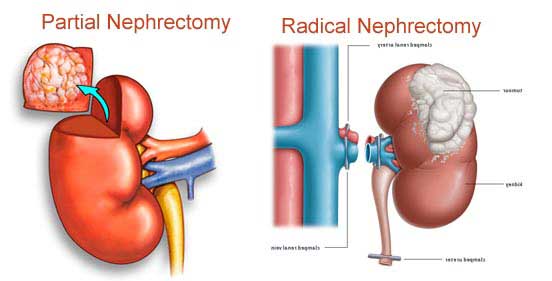Nephrectomy Surgery in India |
 |
A surgical strategy in which a flank cut is made so that a catheter can be embedded into the kidney pelvis to deplete the kidney, frequently done to diminish block.
Definition
A nephrostomy is a surgical strategy by which a tube, stent, or catheter is embedded through the skin and into the kidney.

Purpose
The ureter is the fibromuscular tube that conveys pee from the kidney to the bladder. When this tube is blocked, pee goes down into the kidney. Genuine, irreversible kidney harm can happen due to this reverse of pee. Contamination is likewise a typical outcome in this stagnant pee.
Nephrostomy is performed in several different circumstances:
-
The ureter is hindered by a kidney stone.
-
The ureter is hindered by a tumor.
-
There is an opening in the ureter or bladder and pee is spilling into the body.
-
As an indicative system to survey kidney life systems.
-
As an indicative system to survey kidney capacity
Reasons for Procedure
A nephrostomy is done to empty pee out of your kidney. This should be done when pee can't turn out through the ureters, bladder, and urethra as it typically does. Particular conditions that may precipitate this include::
-
Damage to the bladder
-
Blockage in ureter (tube that carries urine from the kidney to the bladder) due to:
-
Infection
-
Tumor
-
Kidney stone
A nephrostomy may likewise be utilized to take a gander at the kidneys and ureters before different techniques are done, similar to kidney stone evacuation. This may likewise help your specialist make an analysis..
Description
To begin with, the patient is given a sedative to numb the territory where the catheter will be embedded. The specialist then embeds a needle into the kidney. There are a few imaging advancements, for example, ultrasound and registered tomography (CT) that are utilized to help the specialist control the needle into the right place.
Next, a fine guide wire takes after the needle. The catheter, which is about the same distance across as IV (intravenous) tubing, takes after the aide wire to its appropriate area. The catheter is then associated with a pack outside the body that gathers the pee. The catheter and sack are secured so that the catheter won't haul out. The strategy as a rule takes one to two hours.
Diagnosis/Preparation
Either the day preceding or the day of the nephrostomy, blood tests are taken. Other symptomatic tests done before the system may differ, contingent upon why the nephrostomy is being done, however the patient may have a CT sweep or ultrasound to help the treating doctor find the blockage.
Patients ought not eat for eight hours before a nephrostomy. Upon the arrival of the system, the patient will have an IV line set in a vein in the arm. Through this line, the patient will get anti-infection agents to anticipate contamination, prescription for agony, and liquids. The IV line will stay set up after the strategy for no less than a few hours, and regularly more.
Patients get ready for a nephrostomy ought to audit with their specialist every one of the medicines they are taking. Individuals taking anticoagulants (blood thinners, for example, Coumadin) may need to stop their drug. Individuals taking metformin (Glucophage) may need to quit taking the prescription for a few days previously, then after the fact nephrostomy. Diabetics ought to talk about changing their insulin measurements since fasting is required before the strategy.
Description of Procedure
A nephrostomy is normally done in an outpatient setting, and you won't have to stay in the doctor's facility overnight. The technique is done either by a specialist called an interventional radiologist or a urologist. To begin with, you will be requested that lie on an uncommon x-beam table. An IV will be put to give you solution to help you unwind. Your lower back will be washed with a sterile. Next a sedative will be infused into your lower back. Ultrasound or x-beam pictures will be utilized to find your kidney and aide the specialist. A needle will be embedded through your skin and into your kidney. The specialist will infuse contrast material through the needle to better view the kidney on the x-beam. The catheter will then be put into your kidney. The catheter will leave your skin and be joined to an accumulation pack. A dressing will be set at the insertion site. Pee will deplete from your kidney into the gathering sack.
Aftercare
Outpatients are typically anticipated that would stay in the center or healing center for eight to 12 hours after the method to ensure the nephrostomy tube is working properly.Patients may stay in the doctor's facility a few days. For the most part, individuals feel sore where the catheter is embedded for around a week to 10 days.
Consideration of the nephrostomy tube is vital. It is situated on the patient's back, so it might be important to have somebody help with its consideration. The nephrostomy tube ought to be kept dry and shielded from water when washing up. The skin around it ought to be kept clean, and the dressing over the zone changed as often as possible. It is the fundamental part of the pee seepage framework, and it ought to be dealt with deliberately to keep microscopic organisms and different germs from entering the framework. On the off chance that any germs get into the tubing, they can without much of a stretch cause a kidney contamination. The seepage pack ought not be permitted to delay the floor. On the off chance that the pack ought to coincidentally be sliced or start to break, it must be changed instantly. It is not prescribed to put the seepage pack in a plastic sack on the off chance that it spills.

Possible Complications
Complexities are uncommon, however no method is totally free of danger. In the event that you are wanting to have a nephrostomy, your specialist will audit a rundown of conceivable entanglements, which may include::
-
Bleeding
-
Infection
-
Damage to nearby organs and tissue
-
Kidney function loss
-
Blood clots
-
Reaction to the anesthesia (eg, light-headedness, low blood pressure, wheezing)
-
Pain
Factors that may increase the risk of complications include:
-
Liver failure
-
Pregnancy
-
Use of blood thinners
-
Long-term illness
Risks
A nephrostomy is a built up and for the most part safe strategy. Similarly as with all operations, there is dependably a danger of hypersensitive response to anesthesia, dying, and contamination.
Wounding at the catheter insertion site happens in about portion of individuals who have a nephrostomy. This is a minor confusion. Real intricacies incorporate the accompanying::
-
injury to surrounding organs, including bowel perforation, splenic injury, and liver injury
-
infection, leading to septicemia
-
significant loss of functioning kidney tissue (<1%)
-
delayed bleeding, or hemorrhage (<0.5%)
-
blocking of a kidney artery (<0.5%)
Normal results
In a fruitful nephrostomy, the catheter is embedded, and pee channels into the accumulation pack. To what extent the catheter stays set up relies on upon the explanation behind its insertion. In individuals with pelvic malignancy or bladder growth where the ureter is obstructed by a tumor, the catheter will stay set up until the tumor is surgically evacuated. On the off chance that the malignancy is inoperable, the catheter may need to stay set up for whatever remains of the patient's life.
|
 |
|
|
|





